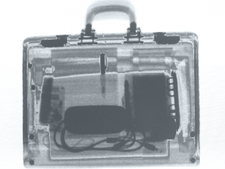-
Topics
Subnavigation
Topics
Electromagnetic fields
- What are electromagnetic fields?
- High-frequency fields
- Radiation protection in mobile communication
- Static and low-frequency fields
- Radiation protection relating to the expansion of the national grid
- Radiation protection in electromobility
- The Competence Centre for Electromagnetic Fields
Optical radiation
- What is optical radiation?
- UV radiation
- Visible light
- Infrared radiation
- Application in medicine and wellness
- Application in daily life and technology
Ionising radiation
- What is ionising radiation?
- Radioactivity in the environment
- Applications in medicine
- Applications in daily life and in technology
- Radioactive radiation sources in Germany
- Register high-level radioactive radiation sources
- Type approval procedure
- Items claiming to provide beneficial effects of radiation
- Cabin luggage security checks
- Radioactive materials in watches
- Ionisation smoke detectors (ISM)
- Radiation effects
- What are the effects of radiation?
- Effects of selected radioactive materials
- Consequences of a radiation accident
- Cancer and leukaemia
- Hereditary radiation damage
- Individual radiosensitivity
- Epidemiology of radiation-induced diseases
- Ionising radiation: positive effects?
- Radiation protection
- Nuclear accident management
- Service offers
-
The BfS
Subnavigation
The BfS
- Working at the BfS
- About us
- Science and research
- Laws and regulations
- Radiation Protection Act
- Ordinance on Protection against the Harmful Effects of Ionising Radiation
- Ordinance on Protection against the Harmful Effects of Non-ionising Radiation in Human Applications (NiSV)
- Frequently applied legal provisions
- Dose coefficients to calculate radiation exposure
- Links
Security screening of hand baggage using X-ray scanners
- The operation of X-ray scanners for the security screening of hand baggage at airports is subject to the provisions of the German Radiation Protection Act (StrlSchG) and the German Radiation Protection Ordinance (StrlSchV) and to the control of the competent German Länder authorities.
- The radiation exposure to the passengers during hand baggage screening does not exceed 0.2 microsievert even in a worst-case-scenario.
- A radiation exposure of 0.2 microsievert corresponds to the dose a passenger receives during a trans-Atlantic flight at cruising altitude within two minutes.
Baggage screening has been established worldwide to enhance air traffic security and is performed by means of so-called X-ray scanners. These X-ray scanners are designed in a way that only a very small fraction of the X-rays used for internal screening can be measured outside the machine.
Airport operators and competent authorities agree upon the fact that the screening of hand baggage by X-ray scanners is justified as the individual and collective security gained by their utilization considerably outweighs the associated comparatively low radiation exposure of an individual person.
Legal basis for hand baggage screening
In Germany, the security screening of hand baggage using X-ray scanners at airports is performed on the basis of the German Aviation Security Act (LuftSiG) which has implemented the Regulation 300/2008 in connection with 185/2010 of the European Union (EU) on civil aviation security into national law. With respect to radiation protection, the provisions of the the German Radiation Protection Act (StrlSchG) and the "Radiation Protection Ordinance (StrlSchV)" apply for passengers and employees.

![]() Suitcase screened by an X-ray scanner
Suitcase screened by an X-ray scanner
There are comparable legal provisions for radiation protection in all member states of the European Union as every member state has to implement the EU Directives on radiation protection into legally binding national set of rules. Countries outside the EU set up their radiation protection regulations based on recommendations by the International Atomic Energy Agency (IAEA) and the International Commission on Radiological Protection (ICRP).
Operation of X-ray scanners for hand baggage subject to the control of the Länder authorities in Germany
The operation of X-ray scanners for the security screening of hand baggage at airports is subject to the provisions of the German Radiation Protection Act (StrlSchG) and the German Radiation Protection Ordinance (StrlSchV) and to the supervision by the competent German Länder authorities. The utilised X-ray scanners are inspected regularly by authority-appointed experts. The testing results have to verify that in the area surrounding the machine in which employees or other third parties may be present, the permissible annual dose limit for an individual member of the public of one millisievert (1 mSv, including pregnant women and children) is not exceeded even in the case of permanent presence.
For this reason, it is not necessary to establish radiation protection areas. That is also why employees in charge of baggage screening are not considered to be occupationally exposed individuals and thus are not required to wear a dosimeter.
Radiation dose from baggage screening is not even a problem for frequent flyers
Even under unfavourable assumptions, the radiation exposure to the passengers during hand baggage screening does not exceed 0.2 microsievert (µSv). Even for individuals who fly frequently, this radiation exposure is far lower compared to the exposure received by the security personnel who are permanently present in the area surrounding the machine during a shift.
Every airline passenger is permanently exposed to naturally occurring cosmic radiation during a flight which is much higher than the maximum possible radiation exposure during baggage screening. A radiation exposure of 0.2 µSv corresponds to the dose a passenger receives during a trans-Atlantic flight at cruising altitude within two minutes. Hence, the proportion of the dose from baggage screening amounts to only a few per mill of the total radiation dose received during a trans-Atlantic flight.
State of 2025.03.25




